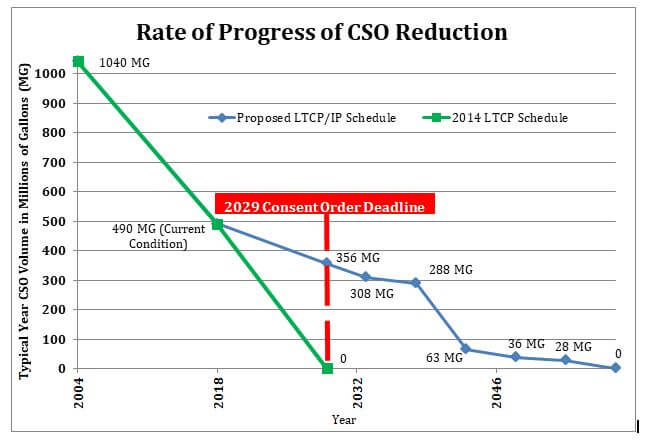The MDC and the Connecticut River Conservancy (then the Connecticut River Watershed Council) stood together in educating the public on how crucial it is to invest in the elimination and reduction in raw sewage that flows into the rivers and streams in our community in order to garner support for the Clean Water Project. Rate payers and the general public must remember that this work is not being done because it was forced upon the MDC by CT DEEP and the EPA, but because it has public health and environmental health benefits to our community and downstream communities.
Since this work began in 2004, the CSO volume in a typical year has been reduced by almost half! We are almost there! The Connecticut River Conservancy has always recognized that this work will take decades, that it is expensive, and that plans should be updated periodically based on lessons learned during implementation. However, the MDC should not be delaying the work required to meet public and environmental health standards to the magnitude proposed in their Recommended Plan. This work is important not just for the health of our rivers, but also for the health of our communities and residents here, all those downstream of us, and those who benefit from the health of Long Island Sound. In 2012 when voters approved this work, we were told the track record of being on time and on budget would continue. This delayed timeline is not what voters approved. In fact, CT DEEP explicitly told MDC not to include a delay/extension of the magnitude presented in the Recommended Plan.
Timeline and CSO Reduction Compliance
The 2018 Long Term Control Plan update does not comply with the current consent order. The MDC is required, by legally binding agreement, to complete all CSO-related projects by 2029. The MDC is proposing to defer completion of 125 of the 152 projects necessary to meet their obligations beyond the 2029 deadline. In the MDC’s recommended plan, project completion is extended to 2058 despite the fact that the Connecticut’s Department of Energy and Environmental Protection was very clear in a December 26, 2017 correspondence with the MDC that “a thirty or forty-year extension to the current elimination deadline should not be part of MDC’s plan when considering the LTCP update.”
In regard to integrated planning, EPA’s Integrated Municipal Stormwater and Wastewater Planning Approach Framework states, “Where extended time is necessary to achieve compliance, enforcement orders should provide schedules for CWA requirements that prioritize the most significant human health and environmental needs first.” The current 490 MG typical year discharge will not be reduced by half until after 2038 under the recommended plan – twenty years from now and ten years after the deadline in the consent order. The MDC will not be in full compliance until 2058.
The MDC has completed almost half of the work required for CSO reduction in 15 years. While it may be true that this rate is not sustainable, the proposed plan slows down the rate of progress to an unacceptable pace.

The MDC should work more closely and cooperatively with the CT DEEP and include all relevant stakeholders to find a more acceptable alternative to the timeline proposed in the LTCP/IP.
Paying for CSO Reduction
Clean Water Funds are in place to pay for half of the CSO work through grants, the funds should be spent as intended in a timely manner. The Clean Water Fund (CWF) was established as a way to help pay for capital projects that have a broader public benefit. CSO-related projects are eligible for a 50 percent grant and the remaining project cost is eligible for a low-interest loan (typically 2%). CRC is one of many groups that make up the Clean Water Investment Coalition which advocate for adequate funding for this program each year so that entities like the MDC will have the resources to complete this important work.
The MDC is making a dangerous assumption in its projections in the Recommended Plan that sewer rehabilitation projects will be eligible for the 50 percent CWF grants. The CWF was not set up to fund sewer rehabilitation projects as they are the responsibility of our communities. The MDC currently receives the lion’s share of CWF grants because they have large and beneficial projects in the project pipeline that directly relate to CSO reduction work. There are other communities competing for Clean Water Fund grants and projects directly related to CSO reduction and these projects will take priority for funding. MDC stands to lose tens if not hundreds of millions of grant funds each year.
Delaying will not make the cost of the CSO work go away. It will only get more expensive. The public should take note that project costs are in 2018 dollars and many of these projects will not start for twenty to thirty years. These project costs will double or triple by that time.
There should be a clearer incorporation of how Clean Water Funding can be applied to future costs that will reduce costs to towns for projects currently eligible for these funds and abandon the effort to use the CWF for ineligible projects.
Deficiency in Direct Cost/Schedule/Benefits Comparisons
While there are some direct comparisons of cost vs. reduction it is impossible reconcile the project schedule with environmental benefits and CSO reduction. There must be better side by side comparisons as exactly when the MDC will meet the requirements of reducing and eliminating CSOs as required for their recommended plan. In presentations to members towns, the information provided focused solely on cost.
Outreach
MDC has been misleading during this process by only narrowly reaching out to communities about this – not including other non-resident stakeholders (businesses, river-users, etc.) – and by focusing discussion on cost and making it impossible to understand when the CSO work will be completed.
Presentations to Board of Commissioners and Town Councils can hardly be considered robust stakeholder engagement. Stakeholder engagement is one of six Plan Elements laid out in EPA’s framework for integrated plans. The EPA encourages “a process which opens and maintains channels of communication with relevant community stakeholders in order to give full consideration to of the views of others in the planning process” and that entities utilizing the approach “should provide appropriate opportunities that allow for meaningful input during the identification, evaluation, and selection of alternatives and other appropriate aspects of plan development.” Many of these outreach effort focused primarily on project costs and some presentations erroneously reported that the recommended plan meets the requirements of the consent order which is not true as the project schedule does not meet the deadline contained in the order. Furthermore, stakeholders did not have full access to the content of the plan until November 26th and only given two weeks to review three volumes of material.
The MDC formed a Citizen’s Advisory Committee (CAC) in the development of its Long Term Control Plan. The platform for broader stakeholder engagement through the development of the update and integrated plan already exists. The MDC should consider utilizing the CAC in developing a more reasonable timeline for the LTCP/IP.
North Branch Park River Water Quality Study
The water quality study commissioned for the North Branch of the Park River concluded that there were other sources of bacteria than the MDC’s CSO discharge. The fact that any stretch of river or stream has multiple sources of bacteria loading is not a novel concept. When pollution sources that impair our waters are identified, we work to eliminate that source. The impairment due to the direct discharge of sewage to the open channel of the North Branch Park River must be addressed regardless of other contributions.
The Connecticut River Conservancy is ready and willing to participate in an process that involves an appropriate range of relevant stakeholders to find a more acceptable solution to reducing Combined Sewer Overflows while meeting other Clean Water Act Requirements that also meets affordability standards for member towns and rate payers.







